Many regions of the world suffer from a scarcity of drinking water but are close to the ocean. Desalination is, thus, a very important technology. Electrodialysis is a desalination technique which can remove salt ions from water by applying a voltage. However, the required voltage rises with the salt content, which makes the technique very energy-intensive in the case of seawater.
Usually, electrodialysis involves the reduction of water to H2 at the cathode and the oxidation of chloride ions to Cl2 or the oxidation of water to O2 at the anode. This causes anions and cations to move towards the respective electrodes, and the desalinated water is, thus, generated between two membranes in the center of the electrolysis cell. Using electrode reactions with a smaller required voltage could make the process more energy- and cost-efficient.
Do-Hwan Nam and Kyoung-Shin Choi, University of Wisconsin−Madison, USA, have developed an efficient type of electrodialysis cell which uses Bi and BiOCl electrodes. The anode reaction is the oxidation of Bi to BiOCl and the cathode reaction is the reduction of BiOCl to Bi. This reduces the equilibrium voltage of the cell to zero and considerably lowers the required operating voltage.
The desalination performance of the developed cells was analyzed while using different electrolytes. According to the researchers, the results provide a basis for the further improvement of Bi/BiOCl electrodialysis cells.
- Electrochemical Desalination Using Bi/BiOCl Electrodialysis Cells,
Do-Hwan Nam, Kyoung-Shin Choi,
ACS Sustainable Chem. Eng. 2018.
https://doi.org/10.1021/acssuschemeng.8b03906




